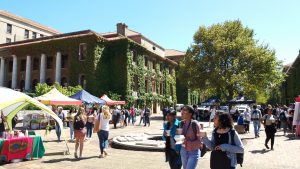
– Writing a data management plan – that’s what applicants struggle with, said Maléne Fouché and laughed wholeheartedly. I had been in South Africa for less than 12 hours but during the meeting with Maléne, the director of Research Integrity & National Grants cluster at the Stellenbosch University (SU), I came to the realization that there may be more similarities in research management between our countries than I initially expected. The coming two weeks seemed to be shaping up as extremely interesting both from the standpoint of my professional career and from the perspective of any cultural differences I might run into.
I was selected as a StoRM (Strengthening of Collaboration, Leadership and Professionalisation in Research Management) intern, and in February I got to spend two weeks at the SU in South Africa. StoRM is funded by the Erasmus+ programme and in a nutshell its aim is to exchange knowledge, tools and best practices in the field of research management between European and South African higher education institutions.
I selected the SU as my host university because of its similarities with the University of Turku. The two universities are of similar size (25-32 000 students) and ranking (QS: 276-361 and World University Ranking: 301-350), and they are internationally known for their high quality research. However, they operate in very different research funding contexts: Finland is the world’s 12th biggest spender on Research and Development per capita whereas South Africa is ranked 55th. Even though Finland is a member of the European Union and South Africa is not, both universities have the same goal of increasing the amount of EU research funding. That’s why EU funding was selected as the focal point of my visit, and I did get to exchange best practices with colleagues from the SU and the University of Cape Town, a larger university nearby. In the end, however, it was the everyday processes that we research managers deal with that proved to be the most fruitful to compare.

Take for example institutional co-funding. For us in Finland it is a no-brainer that a decision about issuing own funding share to a project, for example an Academy of Finland project, is made by the head of department or dean. In Stellenbosch I learned that there the co-funding decisions are made by a field-specific subcommittee, and that whether or not the applicant receives the grant from the funder, the applicant is still allowed to keep the co-funding issued by the subcommittee. And the sums they decide upon are not insignificant since the NRF (National Research Foundation), their equivalent to the Academy of Finland, demands the same amount from the university as they give as a grant.
When it comes to research proposal writing, applicants in Finland and South Africa seem to be having a hard time with the same issues, for example drafting the already mentioned data management plan. Investing more in the impact characteristics of the proposal is also something that applicants in both countries could benefit from. Impact really should be seen as something that covers the entire project from start to finish and it is not only relevant in the later stages when the results start to come in. During my stay, I had a chance to work closely on several occasions with Riana Coetsee, the Manager of International and Early Career Research Grants cluster. Before coming to Stellenbosch, her job entailed reviewing research grant applications, and to a lesser degree, those duties are still a part of her average workday. She revealed the advice she often gives to applicants who struggle with their grant proposals: “I tell them to keep the Five Ws, which also journalists use, in mind while writing. They are: who, what, when, where and why. Answering these questions thoroughly will provide the reviewer with all the necessary information.”
About a week after my return to Turku while I was writing a final report of my internship, I came to realize something that I had been wondering about for a while but still needed the new perspective that I got when visiting research managers on the other side of the world. It was that even though research management has been in existence for several decades now – depending on how you define the concept – it is nonetheless a constantly changing field, which evolves hand in hand with both the higher education institutions and the research done in them. Due to programs like StoRM there is now a chance to visit colleagues abroad and see where we have been and where we are going as a field.
